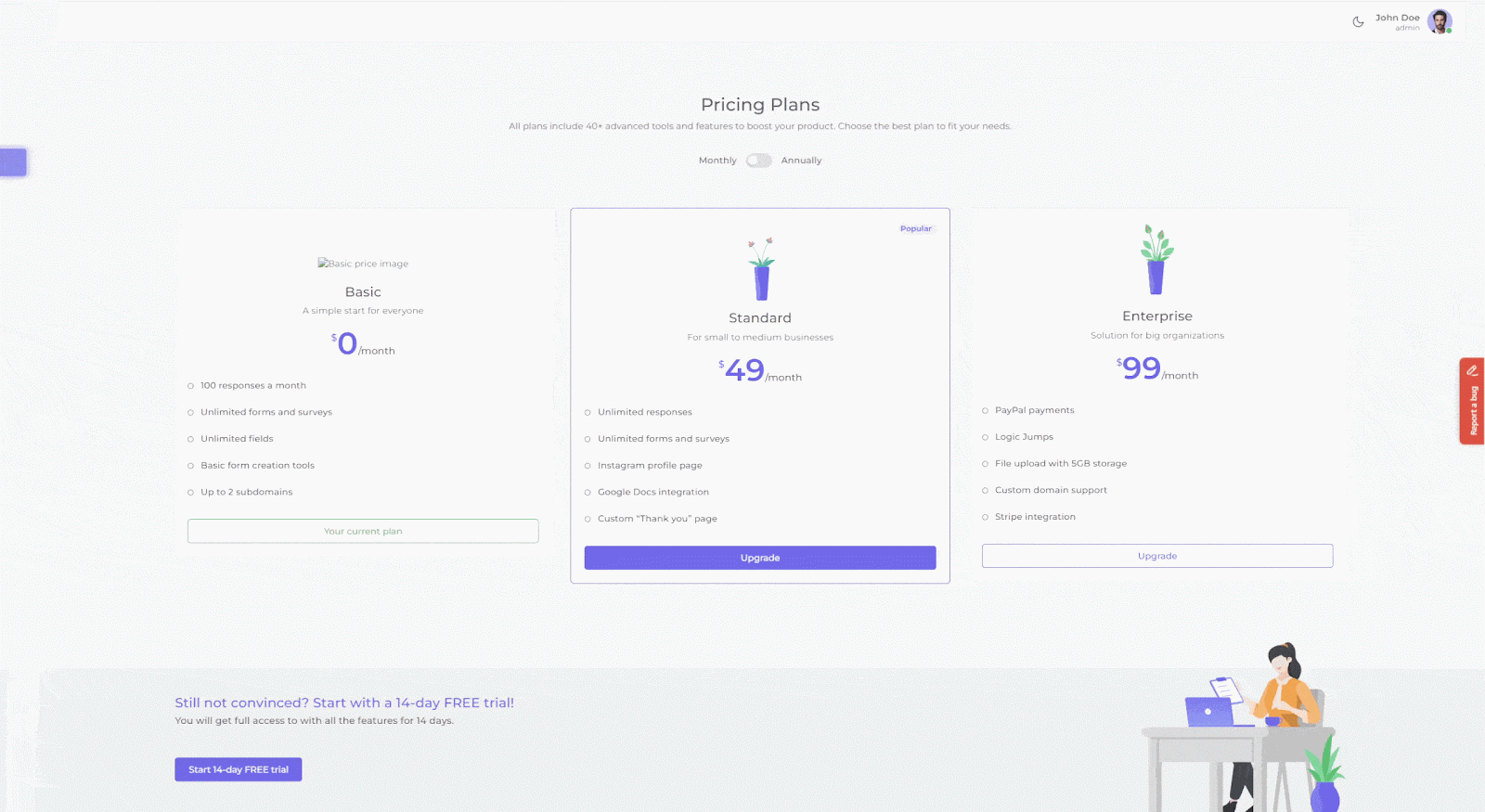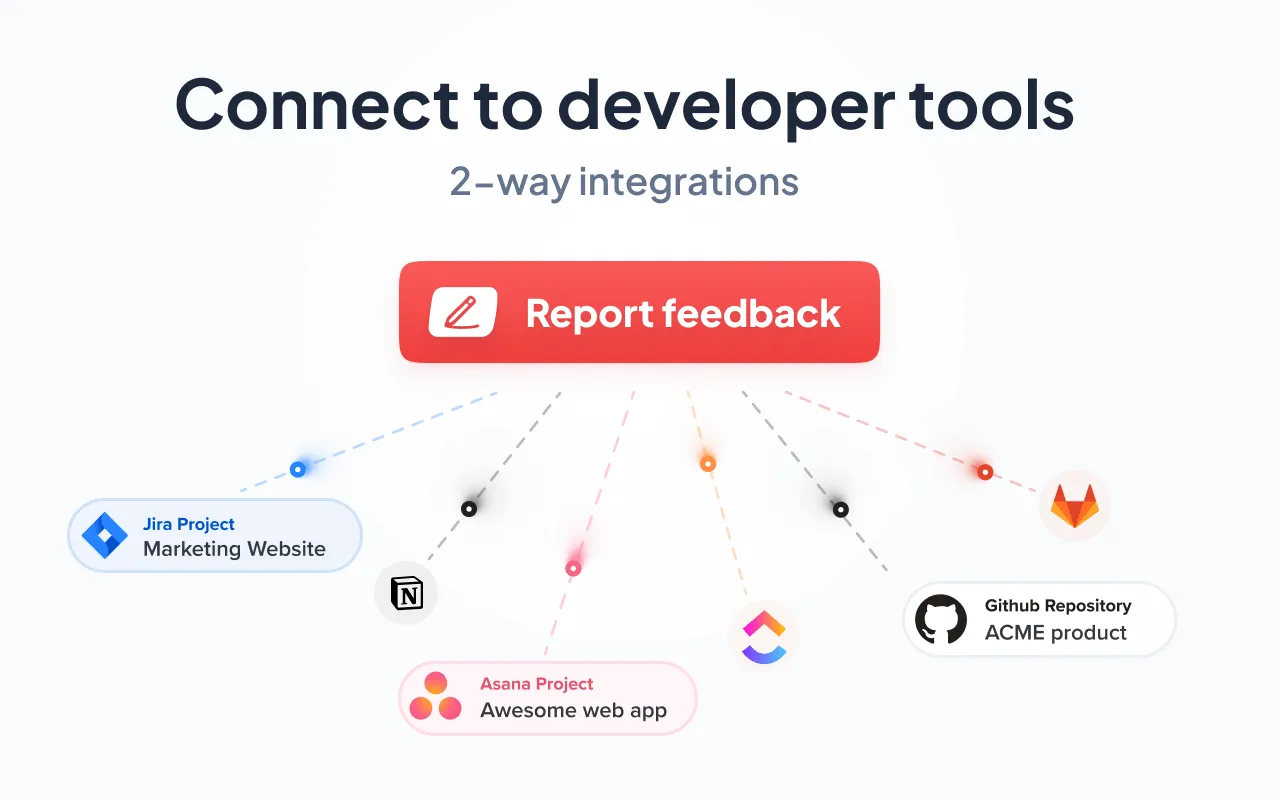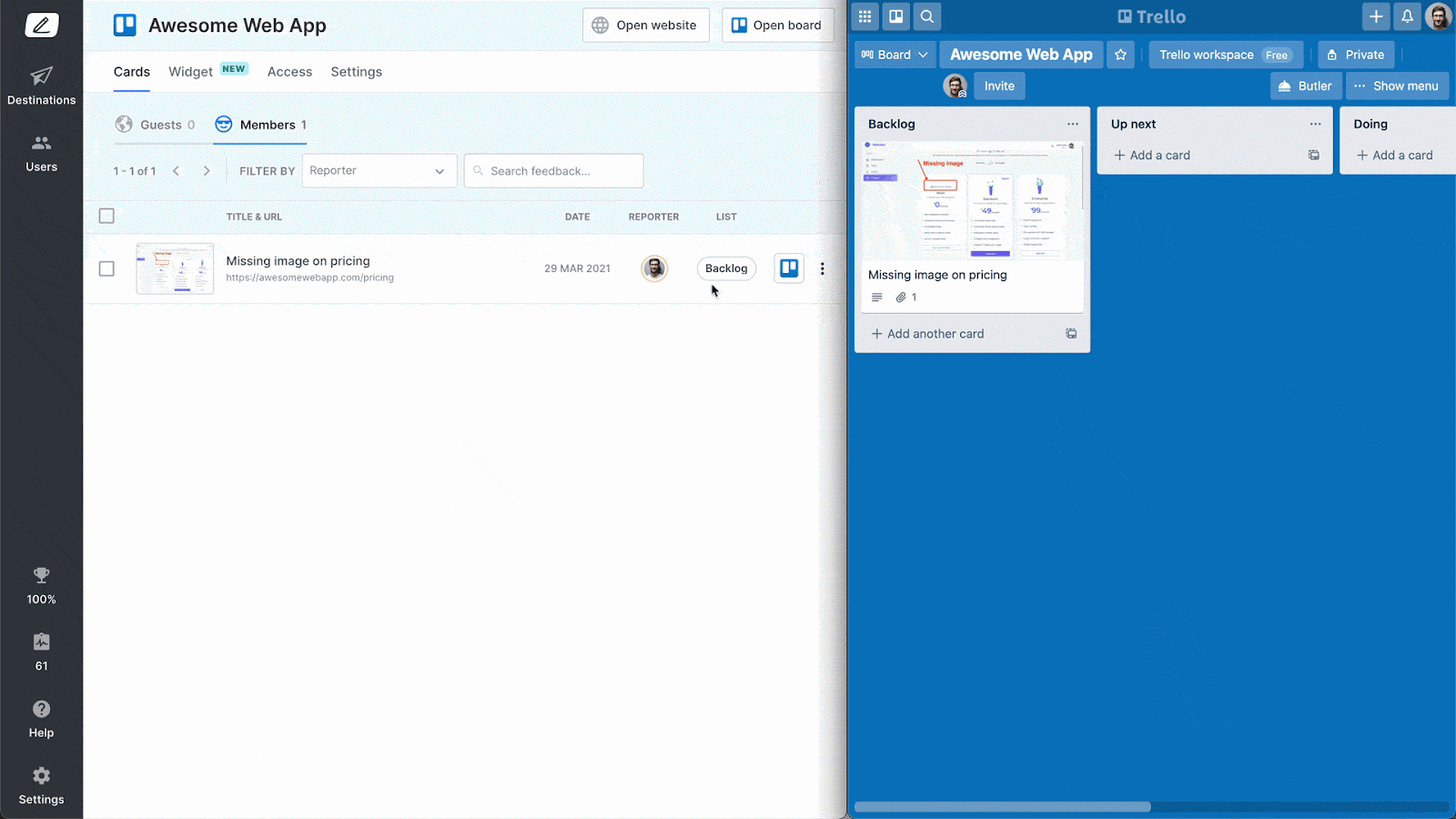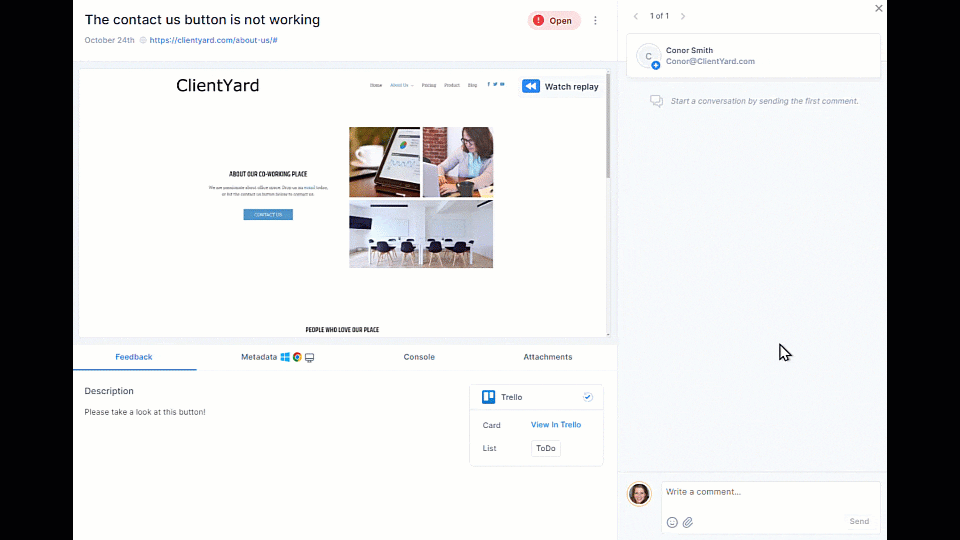15 Best Developer Productivity Tools in 2024: Which One is Right For You?
In this blog post, we look at the 15 best developer productivity tools in 2024 based on features, use cases, and pricing.
In this blog post, we look at the 15 best developer productivity tools in 2024 based on features, use cases, and pricing.
There are countless developer productivity tools out there. It could take you days or even weeks to sift through them all.
But who has time for that?
In our productivity-driven world, developers and product managers need to be efficient. Being productive is just as crucial as writing clean code.
To help you save time, we've compiled this guide to the 15 best developer productivity tools available.
Let’s dive right in.
15 Best Developer Productivity Tools
Here is our list of the 15 best productivity tools for developers, comparing features, use cases, and pricing.
1. Marker.io

One-click plugin for websites to capture bug reports and sync them directly to your project management (PM) software.
Developers, product managers, and QA teams need a bug tracking solution that solves several problems at once:
- Easy to use: Whether as a WordPress plugin or a code snippet, this bug-tracking tool can be used on any staging or live site, app, or new SaaS product.
- Collects everything: It captures everything from visuals to video, plus all the details developers need to fix bugs, like console and environment logs, and much more!
- Auto sync with PM tools: No more email overload or lost bug reports in Slack messages. Every report goes directly into your PM software, eliminating the need to switch between apps.
Marker.io meets all these needs and more.
Here are a few more reasons why Marker.io is a great bug tracking and productivity tool for developers.
Visual feedback

When colleagues, clients, testers, or QA teams encounter bugs and other issues on a live or staging website, they need a quick and easy way to report them.
A one-click reporting solution makes this process easier for everyone involved.
Marker.io makes bug reports easy to submit and ensures they contain enough data to be actionable for software engineers.
These reports include visual feedback and annotations, reducing the time spent trying to understand how to fix a bug.
Marker.io's visual feedback tool includes screenshots and more:
- Arrows
- Shapes
- Text over screenshots
- Blur (for sensitive information…)
- Different colors
- Emojis
Sending this feedback via Marker.io is a simple, 3-step process:
- Notice something that needs changing? Just click the button.
- Fill out the report and input details.
- Click “Create issue”—done!
You can also create more detailed reports for internal team members.
Marker.io can be installed on any website or app via a snippet of code, or it can be embedded as a WordPress plugin.
See it in action:

Detailed bug reports

Software engineers need detailed information to replicate and fix bugs.
For example, is the problem browser-specific (e.g., Chrome or Firefox), or is it happening in specific cases only?
Developers need tools that tell them:
- What URL a client or tester was on;
- Environment (operating system, device, browser, etc.)and console logs so devs can reproduce the bugs;
- Technical metadata;
- Session replay/recordings, etc.
With Marker.io, this data comes with every feedback and bug report and is auto-synced straight into your PM software (we integrate with dozens, such as Jira, Trello, Asana, etc.).
2-way sync with PM tools

One of the main advantages of Marker.io is the deep 2-way integrations with project management tools.
You don’t need to go back and forth between Marker.io and your PM software.
Marker.io integrates seamlessly with ClickUp, Jira, Trello, Linear, and many others.
The benefits are:
- Every bug report submitted automatically goes into your PM tool;
- Nothing gets overlooked or lost in email or Slack;
- When an issue is marked as “Done” in your PM tool, it will be marked as “Resolved” in Marker.io.
- Product managers can even ensure every stakeholder is automatically notified.
Check out our 2-way sync in action:

Session replay

Even with annotations, screenshots, and technical data, software engineering teams can fix any issue more quickly when they can see what a team member, client, or user was doing when they submitted feedback.
Marker.io's toolkit includes session replay so anyone who’s assigned to fix bug reports can see, replicate, and then resolve the problem.
Every recording goes straight into your PM tool. Simply click the “Watch replay” link.
Session replay recordings show the last 30 seconds (or more) before a bug report was submitted.
Check out session replay in action:

Interested in trying Marker.io?
Try Marker.io free for 15 days as an easy-to-use productivity tool for bug tracking and reporting.
Pricing: starts at $39/mo.
2. GitHub

Version control, productivity, collaboration, and now AI-powered software development in one platform.
GitHub is popular with developers, enabling efficient code sharing, reviews, and version tracking. Features include:
- Integrated issue tracking to help developers keep track of bugs and feature requests.
- Built-in CI/CD pipelines that automate the software delivery process.
- Robust integration capabilities with other developer tools, like Jira and Slack.
- An exciting new feature is GitHub Copilot X, an AI-powered pair programmer (built on OpenAI’s GPT-4).
Pricing: From $4/mo per user or $21/mo per user for Enterprise-level services.
3. The Silver Searcher

Open-source tool for quick and efficient text pattern searches in large codebases.
The Silver Searcher is an open-source tool that significantly improves the navigation and understanding of any codebase.
It started as a clone of Ack, except it’s 5-10x faster. Features include:
- Multi-threading for faster code bug searches.
- Ignores file patterns from your .gitignore, .ignore, and .hgignore to avoid unnecessary searches.
- Customizable via command-line options and a downloadable config file.
Pricing: Free (open-source).
4. GitLab

Popular and comprehensive AI-powered DevSecOps Platform.
GitLab’s features include:
- Complete toolset for the entire software development lifecycle (DevSecOps), enhancing collaboration and productivity.
- Includes GitLab Duo for AI-powered workflows and pair programming.
- Built-in CI/CD for test automation and deployment.
- Integrated issue tracking and project management tools.
- Supports containerization and Kubernetes integration.
Pricing: From $29/mo (per user).
5. CodeStream

Open-source extension for IDE platforms, compatible with VS Code, Visual Studio, and JetBrains.
CodeStream is an IDE collaboration plugin that integrates with various tools and platforms.
Key features include:
- In-IDE code discussion and review, reducing context-switching.
- Integrated code comments and issue tracking, simplifying communication.
- Supports live code review sessions with integrations including GitHub, GitLab, VS Code, Visual Studio, JetBrains, Jira, Slack, and more.
Pricing: Free (open-source).
6. Linear

Project management tool designed to streamline software and website development.
Linear improves workflow and collaboration with features for issue tracking, prioritization, and team coordination, including:
- Seamless integration with other tools like Slack, GitHub, etc.
- Full project development lifecycle management and project tracking for monitoring team progress.
- Supports product roadmaps, sprints, and keyboard control and shortcuts for greater efficiency.
Pricing: Starts at $10/mo (per user).
7. Salt

Open-source automation and configuration management tool supported by a community of developers.
Salt helps developers and systems administrators orchestrate and control complex SaaS infrastructures, saving time and reducing errors.
Key features include:
- Event-driven automation for real-time reaction to system events.
- Supports cloud, container, IDE, network automation, and numerous integrations (including GitHub).
- Ideal for large-scale systems with thousands of servers, especially when used with VMware.
Pricing: Free (open-source).
8. Visual Studio Code

Lightweight yet powerful source code editor.
Visual Studio Code is open-source and supports nearly every programming language. It includes tools for debugging, task running, and version control.
Key features include:
- Tools for efficient code writing and debugging
- An extensive marketplace of extensions for customization and enhanced functionality.
- Integrated terminal for command-line operations and live, real-time collaboration and productivity solutions.
Pricing: Free (open-source).
9. Postman

Streamlines the process of developing, testing, and documenting APIs.
Postman accelerates API development, leading to more robust applications. It offers:
- Automated testing with collections, workspaces, and repositories.
- Collaboration on API development through shared workspaces.
- Comprehensive API documentation tools and governance rules.
Pricing: Starts at $12 per user per month.
10. Sourcegraph

Enhances developer productivity with code search and AI assistants.
Sourcegraph is a code search tool that helps developer teams navigate, understand, and fix codebase issues faster.
With it, you can:
- Find code and patterns using examples and the AI assistant.
- Use code intelligence features like hover tooltips, go-to-definition, and find-references.
- Make batch changes across multiple repositories and locate where code is hosted.
- Use the VS Code extension and a (beta) JetBrains IDE plugin.
Pricing: Free (open-source).
11. Sentry

Helps developers monitor and fix crashes in real-time with error tracking.
Sentry offers tools to enhance software quality and reduce troubleshooting time. With it, you can:
- Get detailed stack traces and context for errors.
- Fix issues in real-time across various programming languages and frameworks.
- Integrate with other productivity, developer, and communication tools.
Pricing: $26 per user per month (when billed annually).
12. F.lux

Free, open-source software tool that adjusts your computer screen's color temperature.
F.lux modifies your monitor's brightness based on day-to-night cycles, preventing negative impacts on your productivity and sleep patterns.
F.lux features include:
- Automatic syncing for daylight changes in your timezone.
- Customizable light settings based on personal preferences or tasks.
- A disable feature for color-sensitive tasks.
Pricing: Free (open-source).
13. Cold Turkey

Blocks distractions like social media, games, or other apps to boost productivity.
Cold Turkey helps developers focus by minimizing interruptions. With it, you can:
- Schedule distraction blocklists for specific core working times.
- Get statistics on time spent/blocked from apps or websites.
- Use “Frozen Turkey” to lock yourself out of your computer for a set period, encouraging breaks.
Pricing: $35.00, a one-time purchase, after a 7-day free trial.
14. iTerm2

Terminal emulator for macOS that brings advanced features to the native terminal.
iTerm2 offers an array of features that go beyond what the built-in macOS terminal provides, such as:
- Split panes to work on multiple tasks or view multiple streams of output simultaneously
- Hotkey-activated "visor" to quickly bring up and hide a terminal window
- Search function to easily find previous commands or output.
- Integrates with tmux, allowing for window splitting and navigation right from iTerm2.
Pricing: Free, open-source software.
15. Traqq

Time tracking and productivity management tool.
Best for: Individuals and teams seeking an automated approach to time tracking.
With Traqq, users can easily track their work hours and get insights to enhance productivity and work habits. It is a valuable tool for freelancers, remote teams, and businesses aiming to improve time management.
Key features:
- Automated time tracking
- Website and application monitoring for a comprehensive overview of online activities
- Data encryption for enhanced security
- Screenshots and activity levels
- Customizable reports for tailored analysis
Pros: Accurate and automated time tracking, comprehensive productivity analytics, user-friendly interface.
Cons: No mobile app, limiting flexibility for users who require on-the-go access.
Pricing: Free plan available. Premium plans start at $6/user/mo.
Frequently Asked Questions
How do you measure developer productivity?
Developer productivity is gauged by an engineering team’s ability to deliver high-quality code that adds value to the business.
For web development agencies, the value is delivered to clients, and outputs are measured against a project’s billable hours.
The longer a project takes from ideation to sign-off, the less profitable it is, making a productive developer team valuable.
Key performance indicators (KPIs) to measure developer productivity include:
- Outcomes over outputs: Measure the end-result rather than the number of lines of code developers write.
- Team outputs vs. individuals: Measure the collaborative outcomes of the team instead of what specific engineers are doing.
- Cycle time: Monitor the time it takes from the first commit to production. Longer cycle times indicate process or tool issues.
- Development frequency: Teams that release code often have a stable delivery pipeline.
- Code quality: Features, apps, websites, and updates that contain lots of bugs are a problem. This shows that a team is releasing code either too fast or without any focus on quality assurance (QA).
What features should you look for in a developer productivity tool?
Productivity tools vary greatly, so there's no one-size-fits-all feature list
Instead, consider your team's productivity hurdles. Identify recurring issues, like a high rate of rework.
Then, choose a tool that can tackle these problems.
What are the advantages of using developer productivity tools?
The main benefit of a productivity tool is, well, increased productivity.
If you can see a positive change in productivity after using a tool, it's worth the investment.
This is especially true if your developers notice an improvement in their work.
A good sign is an increase in productivity KPIs and a decrease in issues like bugs and code errors.
We hope this guide comparing the top 15 developer productivity tools has been useful.
Each tool has its strengths and weaknesses.
You might need several tools to fully benefit from their features.
Did we miss one? Let us know by email or on Twitter!
What should I do now?
Here are three ways you can continue your journey towards delivering bug-free websites:
Schedule a demo with us to see Marker.io in action. We’ll personalize the session to your needs and answer any questions.
Read Next-Gen QA: How Companies Can Save Up To $125,000 A Year by adopting better bug reporting and resolution practices (no e-mail required).
Follow us on LinkedIn, YouTube, and X (Twitter) for bite-sized insights on all things QA testing, software development, bug resolution, and more.
Frequently Asked Questions
What is Marker.io?
Who is Marker.io for?
It’s perfect for agencies and software development teams who need to collect client and internal feedback during development, or user feedback on live websites.
How easy is it to set up?
Embed a few lines of code on your website and start collecting client feedback with screenshots, annotations & advanced technical meta-data! We also have a no-code WordPress plugin and a browser extension.
Will Marker.io slow down my website?
No, it won't.
The Marker.io script is engineered to run entirely in the background and should never cause your site to perform slowly.
Do clients need an account to send feedback?
No, anyone can submit feedback and send comments without an account.
How much does it cost?
Plans start as low as $49/mo per month. Each plan comes with a 15-day free trial. For more information, check out the pricing page.
Get started now
Free 15-day trial • No credit card required • Cancel anytime






![How to Write a Good Bug Report [Step-By-Step Guide]](https://cdn.prod.website-files.com/671900dacbf828ea7d4ce0c4/671cc18e0f6b41c5c48160d4_64380d0eb677f0c6c24e62ae_how-to-write-bug-report.webp)